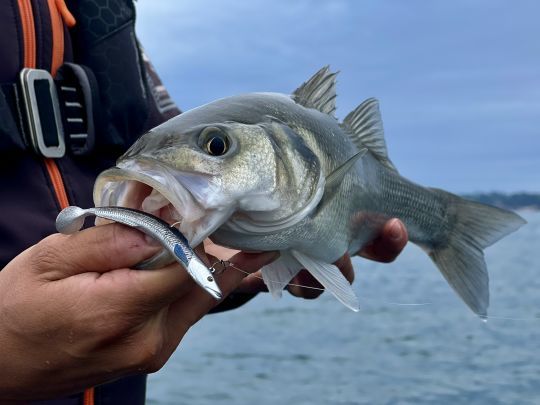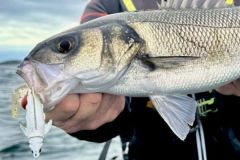Linear fishing
This is undoubtedly the simplest technique for bass fishing. As the name suggests, it involves a continuous, linear retrieve of the lure through the water.

There are two possible scenarios:
- Cast-and-reel fishing: this method consists of casting the lure and reeling it in with a continuous retrieve. Let the lure make contact with the bottom before starting the retrieve. This method is essentially practice with shads, which are lures capable of swimming on their own due to their paddle shape.
- Vertical fishing: this method is used directly over the boat when the bottom exceeds 20 metres. As before, retrieve the lure with the reel until it reaches the boat.

In both cases, a little extra can increase your chances of capture. Remember to take a break, of varying length, before resuming the retrieve. Alternate retrieve speeds to simulate erratic swimming.
The lures best suited to this fishing technique are shads, as mentioned above. Adapt the size and weight of the lure to the fishing conditions (wind, current, depth, size of prey in the area).
Fly-fishing
The second technique to master is fly-fishing. This is done when the fish are active, either on a bird hunt or when the bass are visible on the depth sounder.

Here, I turn to lures that I animate quickly. Fiiish's Crazy Sand Eel is my favourite for this situation. It imitates to perfection a fleeing sand lance on a bass hunt.
Once the lure is cast, I don't try to make contact with the bottom, but let it drop just a few metres. In theory, 1 metre per second.
Once at the desired depth, I retrieve the lure while animating it with scion strokes. This gives the lure an erratic swimming action that bass love (twitching).

You can also try a very fast linear recovery.
This practice is aimed at active, hunting fish. It is not suitable when bass are stuck to the bottom.
Scratch fishing
This last basic technique is designed to target fish close to the bottom. As the name suggests, the aim is to scrape the bottom.
Turn to a lure with a Texan hook. This will prevent you from getting hooked.
Unsurprisingly, I can only recommend Fiiish's Black Minnow in size 120 or 140, depending on the weight required.

The technique involves casting forward and making contact with the bottom. Once you've made contact, make a few wide pulls to bring the lure as close to the bottom as possible before letting it drop back. Repeat until the line is fully retrieved.
This method is particularly effective at the start of the season, when bass feed mainly on crabs, shrimps and other small crustaceans.

There are other techniques that I haven't developed here, such as pull-fishing, which is very effective but not necessarily suitable for beginners. It's best used in areas with strong currents, where a certain amount of control is required to get the lure moving.
By mastering these three basic techniques, you'll have the technical range you need to animate your lures.





















